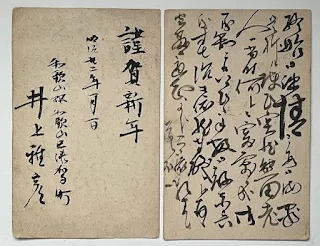前田吉彦の六人の謎の仲間 1889-1891
明治22年和歌山の井上雅彦からのはがき
Both of these cards were sent by Inoue Masahiko from Wakayama, postmarked Kii Wakayama (紀伊 和歌山). They are dated January 1, 1889, and June 26, 1889. Unfortunately, we have not been able to determine his connection to Maeda Yoshihiko, nor have we found any additional information on Inoue Masahiko.
但馬国養父郡屋岡尋常小学校の田中芳郎
This New Year's greeting was sent to Maeda Yoshihiko by Tanaka Yoshiro (田中芳郎). The postmark is from Yoka, Tajima (但馬, 八鹿) and dated January 1, 1891. Tanaka's return address is listed as Yoka Elementary School in Yabu District, Tajima Province (present-day Hyogo Prefecture), suggesting that he was an educator. Unfortunately, we have not been able to find any additional information about him online.
明治 23・24年の年賀状、但馬村岡の玉河から神戸の前田吉彦 (洋画家)
Dated January 1, 1890 and January 1, 1891, these postal cards were postmarked in Tajima Muraoka (但馬村岡) and sent by an individual named Tamagawa (玉河) from Tajima, Shitsumi-gun, Muraokacho (但馬七美郡村岡町). Unfortunately, the identity of Tamagawa remains unknown.
明治22年但馬出石町の島村から前田吉彦先生宛の年賀状
Both of these cards originate from Tajima, Izushicho (Hyogo). The first card, dated January 2, 1889, was addressed to Maeda Yoshihiko 殿 (dono, meaning "mister") by Shimamura Hide (島村秀?). The second card, dated January 1, 1890, was sent by Shimamura Hamasaburo (島村濱三郎?). This card is addressed to Maeda Yoshihiko 先生 (sensei, meaning "teacher"). Judging from the forms of address used, Shimamura Hide was likely older than Shimamura Hamasaburo and may have been Hamasaburo's father. However, this is merely conjecture, as we were unable to find any further information on these individuals.
1889 and 1891 Postal Cards Nagoya Postmarks Unknown Writer
きれいな字ですね。全く読めません。
Aside from Maeda Yoshihiko's name, the text on these postal cards remains indecipherable to us. The dates—August 23, 1889; August 5, 1891; and October 30, 1891—are all we can extract. The sender could very well be a historically significant figure, but unless someone steps forward to transcribe the content, their identity and intentions will remain a mystery.
These cards serve as a poignant reminder of the countless pieces of correspondence that, for lack of transcription or preservation efforts, are likely to fade into obscurity. Each of them represents a fragment of history—possibly invaluable—that might never be fully understood or appreciated.









No comments:
Post a Comment